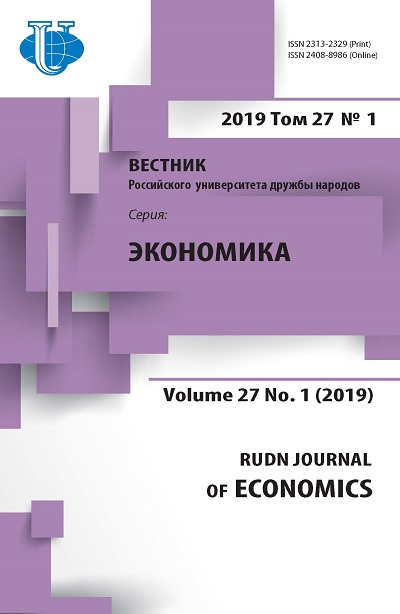Spatial differentiation in the development of territorial systems of public service (an example of Saransk city)
- Authors: Semina I.A.1
-
Affiliations:
- National Research Ogarev Mordovia State University
- Issue: Vol 27, No 1 (2019)
- Pages: 132-139
- Section: REGIONAL ECONOMY
- URL: https://journals.rudn.ru/economics/article/view/21307
- DOI: https://doi.org/10.22363/2313-2329-2019-27-1-132-139
Cite item
Full Text
Abstract
Spatial saturation of a city of consumer product and services leads to the formation of territorial systems of servicing, where service spheres is interacting actively, to complement each other and competing for the consumer. This process covers all of residential area, it differentiats between areas of the city, stands out the centers and complexes of service. They performs only regional function in some urban areas, but there are centers of educational, medical and merchant services citywide and regional significance. It was allocated areas by the nature of the service of the population, security of services, comfort conditions for people’s lives with consideration the complex development social infrastructure and provision of public services in territory of Saransk city. These areas has relatively high complexity of territorial organization of social infrastructure and high endowment the population of services combined with a satisfactory level of comfort of people living conditions; with average complexity of the territorial organization of social infrastructure and high complexity of population services in combination with a low level of comfort of living conditions (influenced by industrial enterprises and highways); with relatively low complexity of territorial organization of social infrastructure and low complexity of population services in combination with a satisfactory level of comfort of living conditions - the private sector of one-story buildings, old buildings. Area has the average complexity of the territorial organization social infrastructure and average endowment of the population services in combination with a satisfactory level of comfort of living conditions for residential peripheral districts of Saransk city. The average complexity of the territorial organization social infrastructure and average endowment of population services in combination with a low level of comfort of living conditions determines to the districts remote from the centre of the city and located in the former industrial plants. The existence of these areas confirms concentric development model spatial structure of Saransk city.
Keywords
About the authors
Irina A. Semina
National Research Ogarev Mordovia State University
Author for correspondence.
Email: Isemina@mail.ru
Сandidate of Geographic Sciences, Assistant Professor, Head of Chair of Physical and Human Geography
68 Bolshevist St., Saransk, 430005, Russian FederationReferences
- Aksenov K., Bradje I., Bondarchuk E. (2006). Transformatsionnoe i post-transformatsionnoe gorodskoe prostranstvo. Leningrad - Sankt Peterburg. 1989-2002 [Transformational and post-transformational urban space. Leningrad - Saint Petersburg. 1989-2002]. Saint Petersburg: Gelikon Pljus Publ.,284. (In Russ.)
- Alekseev A.I., Kovalev S.A., Tkachenko A.A. (1991). Geografiya sfery uslug: osnovnye ponyatiya i metody: uchebnoe posobie [Geography of the service sector: basic concepts and methods: study quide]. Tver, 123. (In Russ.)
- Fedotov Y.D. (2016). Otsenka kachestva gorodskoy sredy v gorode Saranske dlya zhizni i komforta zhizni [The assessment of the urban environment quality in Saransk sity for the life and the living comfort]. Nauchnoe obozrenie, (1). https: https://srjournal.ru/2016/id1 (accessed: 18.10.2018). (In Russ.)
- Folomeykina L.N. (2014). Rynok ekologicheskikh tovarov i uslug regiona [Market for environmental goods and services of a region]. Regionologija, 1(86), 147-154. (In Russ.)
- Folomeykina L.N., Khokhlova E.E. (2016). Audit zemlepol’zovaniya i formirovanie sotsial’no-delovykh zon v gorodakh [Audit of land use and formation of social and business zones in urban areas]. Ogarev-online, (14). http://journal.mrsu.ru/arts/audit-zemlepolzovaniya-i-formirovanieobshhestvenno-delovyx-zon-nagorodskix-territoriyax (accessed: 22.10.2018). (In Russ.)
- Hitz H., Schmid C., Wolff R. (1992). Zur Dialektik der Metropole: Headquarter economy und urbane Bewegungen. Geographische Zeitschrift, 57-83.
- Nosonov A.M. (2016). Territorial’naya organizatsiya tretichnogo sektora: metodologicheskie aspekty issledovaniya [Territorial organization of the tertiary sector: methodological aspects of research]. Nauchnoe obozrenie, (1). https://srjournal.ru/2016/id2 (accessed: 25.10.2018). (In Russ.)
- Percik E.N. (2013). Geograficheskaya mysl’: istoriya, problemy, poisk resheniy. Istoriya i metodologiya geograficheskoy nauki, geograficheskie aspekty gradostroitel’stva i urbanizatsii [Geographical thought: history, problems, search for solutions. History and methodology of geographical science, geographical aspects of urban development and urbanization]. Moscow: Master Publ., 428. (In Russ.)
- Semina I.A. (2017). Razvitie tretichnogo sektora ekonomiki i organizatsiya gorodskogo obshchestvennogo prostranstva (na primere bol’shogo goroda) [The development of the tertiary sector of the economy and the organization of urban public space (on the example of a large city)]. Uspekhi sovremennogo estestvoznanija, (5), 128-133. (In Russ.)
- Semina I.A. (2017). Strukturno-funktsional’nye osobennosti torgovykh tsentrov v Saranske [Structural and functional features of the shopping malls in Saransk]. Modern problems of territorial development, (3). https://terjournal.ru/2017/id23/ (accessed: 20.10.2018). (In Russ.)
- Semina I.A., Nosonov A.M., Kulikov N.D. et al. (2017). Territorial’naya organizatsiya tretichnogo sektora ekonomiki: monografiya [Terrotorial organization of the economy’s tertiary sector: monography]. Saransk: Mordov. un-t Publ., 208. (In Russ.)
- Tkachenko A.A. (2009). Nekotorye element obshchey teori i territorial’noy organizatsii obshchestva [Some elements of the general theory of the territorial organization of society]. Socialnojekonomicheskaja geografija: tradicii i sovremennost’ [Social-economic geography: tradition and modernity]. Moscow-Smolensk: Ojkumena Publ., 215-225. (In Russ.)
- Wallerstein I. (1980). The Modern World - System II. New York: Academic Press.















